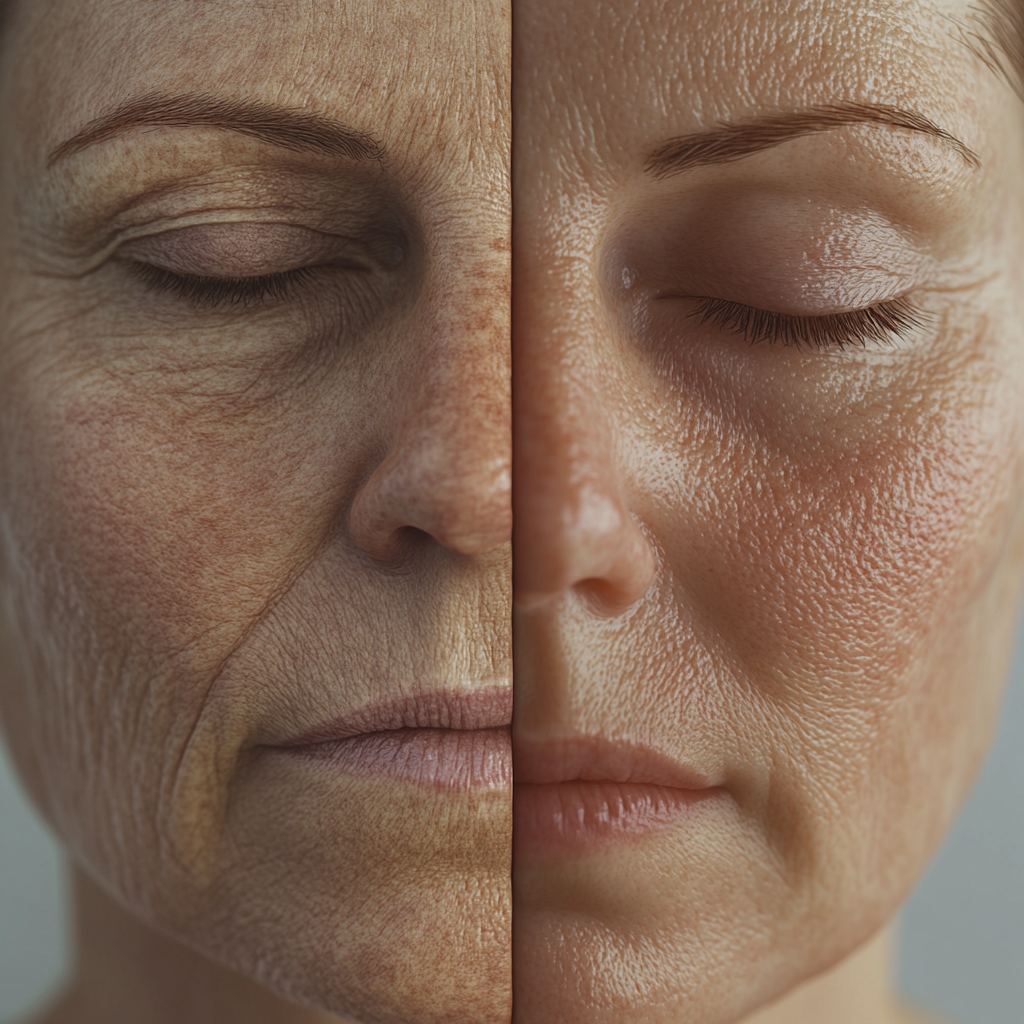
Gut Feelings: Exploring the Gut-Brain Axis and Its Impact on Mental Health
The Gut-Brain Axis Explained The gut-brain axis is a

If you’re passionate about the science of great skin or simply want to maintain your health and radiance naturally, you may have explored collagen’s role in skin health. Questions often arise, like: Can collagen be restored naturally? Do collagen supplements work?
Let’s dive into understanding the layers of skin, how collagen is created and depleted, and how to boost collagen naturally.
The skin is a dynamic ecosystem composed of multiple layers, each contributing to its overall function and appearance. The outermost layer, the epidermis, provides a barrier against environmental threats and regulates moisture. Beneath this lies the dermis, rich in collagen and elastin fibers, which are responsible for the skin’s strength and elasticity. This is where fibroblasts come into play, serving as the architects of your skin’s structural integrity.
Making up about 80% of the skin’s dry weight, collagen is a structural protein known for its unique triple helix and is found in the connective tissues of the body, including skin, tendons, cartilage, organs, and bones.
It plays a crucial role in maintaining the structural integrity and elasticity of the skin. Collagen contributes to skin firmness and hydration, supporting its structural integrity and elasticity.
The production of collagen is closely linked to fibroblasts, specialized cells in the dermis of the skin responsible for synthesizing collagen fibers and other components of the extracellular matrix, ECM.
An ECM is like a sticky web that surrounds cells in your body, providing support and structure, helping them stick together, and allowing them to communicate with each other. Here is a video visualisation.
As we age, the activity of fibroblasts diminishes, leading to a reduction in collagen production, which contributes to signs of aging such as fine lines and facial wrinkles, as well as decreased joint function.
Incorporating healthy strategies such as a nutrient-rich diet and avoiding smoking can support fibroblast activity and enhance skin and joint health, ensuring they remain resilient.

Collagen is an essential protein that plays a crucial role in maintaining skin elasticity, firmness, and overall youthful appearance. There are several types of collagens, each serving distinct functions in the body.
Among these, Type I collagen is the most prevalent in the skin, tendons, and bones; providing structural support. Below we summarize the types of collagens in the body:
If you’re interested in a detailed exploration of collagen types, refer to the research paper published by the National Library of Medicine.
Increases skin firmness and improves its natural bounce, leading to a noticeable reduction in sagging and the appearance of fine lines and wrinkles..
Collagen fragments play a significant role in stimulating the synthesis of hyaluronic acid, which in turn enhances the skin's ability to retain moisture effectively
Type III collagen is especially vital during the initial phases of the skin's healing process, playing a key role in repairing damaged tissues effectively.
Helps in maintaining the structural integrity and resilience of the different layers of the skin, ensuring they remain strong and support overall skin health.
Aging induces a decline in the enzymes involved in the processing of collagen, reducing the number of fibroblasts cells, and blood vessels that supply the skin. This reduces collagen production in the body. Loss of collagen starts in your 30s, with a loss of about 1% per year. This rate of decline increases to approximately 1.5-2% annually in your 50s and beyond. The efficiency of fibroblasts declines, leading to reduced collagen production.
Ultraviolet (UV) radiation is one of the most significant contributors to skin damage, profoundly affecting skin health and collagen synthesis. Prolonged exposure to UV light can initiate oxidative stress, ultimately damaging skin cells and escalating the activity of matrix metalloproteinases (MMPs)—enzymes that break down collagen.
Using broad-spectrum sunscreen of at least SPF 30, and avoiding peak sunlight hours, is essential in safeguarding the skin from harmful UV exposure.
For a deeper understanding of the effects of UV on skin health and strategies for protection, refer to peer-reviewed literature.

Poor diet, smoking, and excessive alcohol consumption can significantly accelerate collagen loss.
Smoking leads to the formation of free radicals, which cause oxidative stress and damage collagen fibers. The harmful chemicals in cigarette smoke reduce blood flow to the skin, impairing the delivery of essential nutrients and oxygen necessary for collagen synthesis. This results in decreased fibroblast activity, which is crucial for producing new collagen. As a result, smokers often experience prematurely aged skin, characterized by increased wrinkles, a loss of elasticity, and a sallow complexion.
Quality sleep is essential for the body’s ability to repair and rejuvenate itself, including the skin. Sleep deprivation elevates inflammation and cortisol levels, compromising moisture retention and increasing damage vulnerability. This disruption can speed up aging, resulting in fine lines, wrinkles, and dullness. Research has shown that inadequate sleep negatively affects collagen synthesis and repair, leading to loss of firmness and resilience. For more, visit the PubMed study.
The concept of “collagen preservation” has become a growing focus, encouraging individuals to support and boost the body’s natural collagen production early in life, typically starting in their late 20s. You can learn more about collagen preservation here.
Regardless of your age, it is never too late to start incorporating the right nutrients, lifestyle choices, and skin routines to boost collagen production. Here are a few steps to get you started on your collagen-boosting journey:

One of the most effective ways to naturally restore collagen in your skin is through proper nutrition. The foods you consume can significantly influence your body’s ability to produce collagen.
We’ve summarized the key nutrients and food sources to include in your balanced diet for optimal collagen support. You can check out our video The Science Behind Collagen Production: Nutrients You Need for Firm, Radiant Skin to learn more about their roles.
One of the most effective ways to naturally restore collagen in your skin is through proper nutrition. The foods you consume can significantly influence your body’s ability to produce collagen.
We’ve summarized the key nutrients and food sources to include in your balanced diet for optimal collagen support. You can check out our video The Science Behind Collagen Production: Nutrients You Need for Firm, Radiant Skin to learn more about their roles.
Tretinoin, a form of vitamin A, is one of the most studied and effective treatments for skin aging. It helps increase collagen production by boosting the turnover of skin cells, improving texture, and reducing fine lines and wrinkles. However, it can be too strong for sensitive skin, so milder alternatives like retinol or retinal may be better choices for those with more delicate skin types. These alternatives offer similar benefits but with less irritation.
If you are interested in learning more about the science behind Tretinoin, check the peer-reviewed study: Retinoids in the treatment of skin aging: an overview of clinical efficacy and safety.
Microneedling, also called collagen induction therapy, involves using a device with tiny needles to create controlled micro-injuries in the skin. This process triggers the body’s natural healing response, stimulating collagen production and improving skin texture. Multiple sessions can lead to noticeable reductions in fine lines, wrinkles, and scars. A clinical study found that after 6 microneedling sessions at 2-week intervals, collagen types I, III, and VII significantly increased in the skin.
Laser treatments, such as fractional CO2 or erbium lasers, specifically target the deeper layers of the skin to stimulate fibroblast activity and increase collagen production.
These treatments work by creating controlled damage to the skin, encouraging the skin to repair itself with fresh collagen and elastin. Laser therapy improves skin elasticity, texture, and tone, and can reduce wrinkles and fine lines.
Laser treatments also help regulate the activity of MMPs (matrix metalloproteinases), enzymes that break down collagen, thereby creating a more favorable environment for collagen production.
You can read the detailed Assessment of Laser Effects on Skin Rejuvenation.
Chemical peels involve applying a solution to the skin to exfoliate the outermost layers, which removes damaged skin and promotes the growth of new, collagen-rich skin.
The peeling solution typically contains alpha hydroxy acids (AHAs) or beta hydroxy acids (BHAs), which are effective in rejuvenating the skin.
Regular chemical peels can also help reduce the appearance of fine lines, age spots, and acne scars.

Let us know what you’d like to see on our blog. We’re always open to ideas and would love to hear from you!

The Gut-Brain Axis Explained The gut-brain axis is a

The Gut – Skin Axis Explained The gut-skin axis

What is “Collagen Banking”? Proactive Strategies for Long-Term Skin
Join our community for expert insights and interviews, and exclusive access to product samples designed to support your wellness from the inside out.